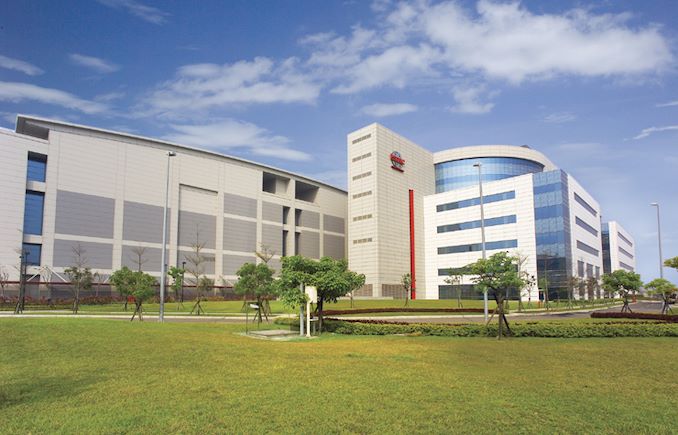TSMC Chip Yields Hit By Bad Chemical Batch
by Anton Shilov on January 29, 2019 11:00 AM EST- Posted in
- Semiconductors
- TSMC

TSMC on Monday said that some of the wafers it has processed recently have lower yields because of a chemical it uses during production. The company began investigation and is in talks with affected customers, thought to include NVIDIA and Huawei, regarding counteractive actions.
The world’s largest contract chipmaker indicated that photoresist chemical it used at its Fab 14B deviated from specifications, which caused wafers to have lower yields. Nikkei Asian Review reports that the factory supplies chips to various customers, including Huawei, NVIDIA, and MediaTek, but does not elaborate which chips and how significant is the yield drop.
TSMC hopes that the affected wafers will still be shipped in Q1, but some shipments will have to be delayed to Q2. The company is evaluating financial impact of the problem and is discussing remedial actions with its customers. In the meantime, TSMC does not expect its first quarter financial results to be significantly different than expected, so the problem may not be too serious.
Last year malware infected some of TSMC’s production tools and affected the company’s operations.
Related Reading
- TSMC: 7nm Now Biggest Share of Revenue
- TSMC: Outbreak of Malware That Triggered Delays & Losses Caused by Software for New Tool
- TSMC: First 7nm EUV Chips Taped Out, 5nm Risk Production in Q2 2019
Sources: Nikkei Asian Review, TSE MOPS










28 Comments
View All Comments
twtech - Tuesday, January 29, 2019 - link
I don't think it points to a public rejection of the raytracing technology - it's that they're expensive products sitting in the no-man's land between not having the feature at all, and having it be capable enough to play games with it at the kind of resolutions and fidelity that someone willing to pay that kind of money for a graphics card expect. I think most people, like myself, are waiting for gen 2 or 3 with acceptable performance, and support in a wider variety of games.DanNeely - Tuesday, January 29, 2019 - link
Based on the demonstrated performance I feel RTX should've been limited to the 2080 Ti primarily as a developer preview feature with wider availability promised when 7nm would let them launch it on enthusiast cards with at least 2x the current number of RTX cores. From there GTX 2080 should've been ~90% of the 2080 in conventional rendering but no ray tracing support, with the rest of the stack rebalanced down from there. The Jury is still out on DLAA and the value of the turing cores outside of ray tracing.Gambling half your die area on aspirational features that won't benefit any existing titles was a huge risk; and unfortunately for NVidia one that appears to've failed for them. At this point the question I'd like an answer to is if they underestimated the amount of ray tracing throughput needed for good performance, or if v1 RTX cores fell significantly short of their expected performance numbers.
mode_13h - Wednesday, January 30, 2019 - link
I'm sure they're selling a ton of TU104's in Tesla T4's, for deep learning/inferencing. In that sense, you can't really call the die area wasted. For games, yeah, but that's not the only use of these chips.Unclear whether they had the volumes to justify a die specifically for this market, but possibly not.
RTX is the odd man out. I'm sure everyone in movie production is using it, but I'm inclined to agree they didn't have to put it in any dies besides their high-end TU102.
PeachNCream - Wednesday, January 30, 2019 - link
Tesla sales aren't as high as expected either. In their latest earnings adjustment announcement, NVIDIA cited slow Turing sales in general and that implies the entire range of products.DanNeely - Wednesday, January 30, 2019 - link
The RTX and Turing cores are roughly half the die area on a TU102/104/106 chip; the huge area is a primary reason why the RTX cards are so expensive and why at a given price point Turing is barely an upgrade over Pascal. It's only survivable for NVidia so far because AMD doesn't have anything competitive in higher performance segments. If Radeon VII or Navi perform as well in terms of absolute performance (even if still behind in perf/watt) as the rumor mills suggest the high prices and near uselessness of the RTX/Turing cores is going to put NVidia in a painful position until they can get their own 7nm chips out.boozed - Tuesday, January 29, 2019 - link
Indeed, given the fraudcoin mining bust and optimistic GPU pricing, they're not going to struggle with a supply hit.imaheadcase - Tuesday, January 29, 2019 - link
Remember when anandtech posted tech hardware related news. I do.bji - Tuesday, January 29, 2019 - link
According to the headline of this article, they did so as recently as January 29, 2019 11:00 AM EST. What's your point?joeyudog - Tuesday, January 29, 2019 - link
According to his username, he'saheadcase.jordanclock - Tuesday, January 29, 2019 - link
How is a problem at the largest semiconductor fab in the world NOT tech hardware news?